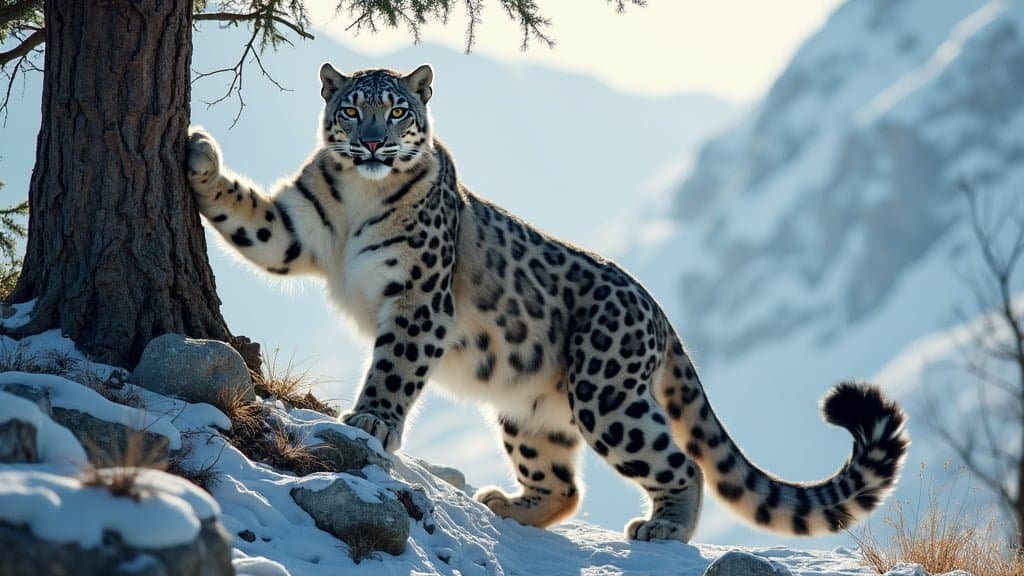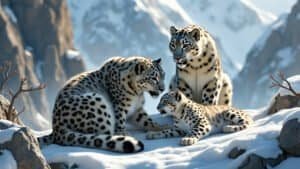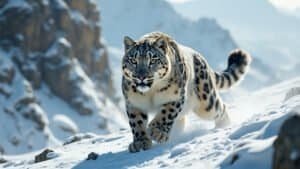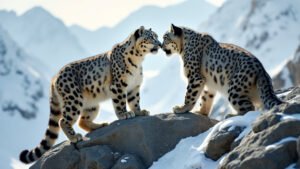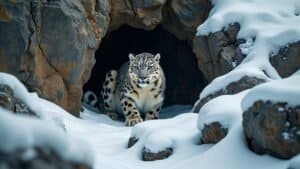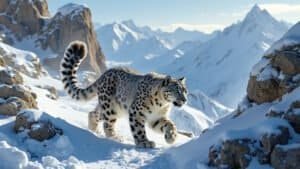Introduction
Snow leopards, elusive and solitary cats of the high mountains, have developed unique ways to mark and defend their territories. This article delves into the various methods snow leopards use for territory marking, including scent marking, scratching, and vocalizations
We will explore the frequency of these markings, the size and extent of their territories, and their interactions with other species. Additionally, we will examine the challenges they face in maintaining their territories due to environmental and human factors. Understanding these aspects is crucial for conservation efforts aimed at protecting these magnificent creatures
Methods of Territory Marking
Snow leopards utilize various techniques to mark their territories, ensuring their presence is known and respected by other leopards and potential competitors. These methods include scent marking, scratching, and vocalizations, each serving a specific purpose in territorial communication
Scent Marking
Scent marking is a primary method snow leopards use to establish and maintain their territories
This involves the use of scent glands located on their cheeks, paws, and the base of their tails. They rub these glands against rocks, trees, and other prominent objects within their territory. This leaves behind a strong, identifiable scent that other snow leopards can detect
The scent contains pheromones, which are chemical signals that convey information about the individual’s identity, reproductive status, and territorial boundaries. This form of communication is particularly important in the vast and rugged landscapes that snow leopards inhabit, where visual and vocal signals might not be as effective
Research has shown that scent marking is used more frequently during the mating season
According to a study published in the journal Behavioral Ecology and Sociobiology (2014), snow leopards increase their scent marking activity to attract mates and signal their availability. This behavior helps maintain genetic diversity and social structure within the snow leopard population
Scratching and Claw Marks
Scratching and leaving claw marks are also essential components of territory marking. Snow leopards use their powerful claws to scratch trees, logs, and even the ground. These visual markers serve several purposes: they indicate the presence of a dominant individual, deter potential intruders, and communicate the physical condition of the marking leopard
Claw marks are often found in conjunction with scent markings, enhancing the territorial message
The depth and freshness of the scratches can provide information about the leopard’s size and recent activity in the area. This method is especially useful in areas with limited vegetation, where scent marks might be less effective due to environmental conditions
In a comprehensive study by the Snow Leopard Trust, researchers observed that scratching behavior is not only a territorial act but also a way to maintain claw health and sharpen them for hunting and defense
This dual function highlights the adaptive nature of this behavior in snow leopards
Vocalizations
While less frequent than scent marking and scratching, vocalizations play a significant role in territory marking and communication
Snow leopards are known for their distinctive calls, which include roars, grunts, and moans. These sounds can carry over long distances, making them effective for communicating across the vast territories snow leopards occupy
Vocalizations are particularly important during the mating season when males and females use calls to find and attract each other. They also serve as warnings to other snow leopards to stay away from an established territory
A study published in the journal Mammalian Biology (2015) highlighted that vocal communication helps reduce direct confrontations, which can be risky and energetically costly for these solitary cats
Snow leopards have adapted their vocalizations to the harsh environments they live in. The calls are designed to travel through mountainous terrain, ensuring they reach the intended recipients. This adaptation underscores the importance of vocalizations in snow leopard social and territorial behavior
Frequency of Territory Marking
Snow leopards maintain a strict regime of territory marking to ensure their presence is continually communicated to other animals. The frequency of these markings varies depending on several factors, including the leopard’s gender, age, reproductive status, and environmental conditions
Daily and Seasonal Patterns
Snow leopards mark their territories daily, with increased activity observed during dawn and dusk, which are their peak activity periods. This routine ensures that their scent marks are fresh and more likely to be detected by other leopards
According to a study published in Ecological Research (2016), the frequency of marking behaviors is higher in the morning and evening, coinciding with their hunting activities. This dual purpose of marking and hunting maximizes their efficiency in maintaining territory and securing prey
Seasonal changes also influence the frequency of territory marking. During the winter months, snow leopards intensify their marking behaviors. The harsh weather conditions and scarcity of prey make it crucial for leopards to assert their dominance and secure their hunting grounds
Conversely, in the spring and summer, when prey is more abundant, the frequency of marking might decrease slightly, although it remains a critical behavior year-round
Differences Between Males and Females
Male snow leopards are generally more active in marking their territories than females. This difference is primarily driven by the need to assert dominance and attract mates. Males typically have larger territories, which they mark more frequently to ward off rivals and signal their reproductive availability
Females, on the other hand, mark their territories to protect their cubs and secure resources
A study by McCarthy et al. in Biological Conservation (2015) found that females with cubs increase their marking activity to ensure the safety of their offspring from other predators and male snow leopards. This behavior highlights the protective nature of female territory marking
Marking frequencies also change during the mating season, with both males and females increasing their activities to facilitate mating encounters. Scent marks become vital communication tools, helping potential mates locate each other across the vast and rugged terrains
Extent of Snow Leopard Territory
The extent of a snow leopard’s territory is vast, varying significantly depending on several factors such as the availability of prey, the presence of other leopards, and environmental conditions
Understanding the size and range of these territories is crucial for conservation efforts and ensuring the survival of this elusive species
Size and Range
Snow leopard territories can cover an expansive area, ranging from 50 to 200 square miles (130 to 520 square kilometers)
The size of a territory is largely dependent on the density of prey within the region. In areas where prey is abundant, snow leopard territories tend to be smaller, as they do not need to travel far to find food. Conversely, in regions with sparse prey, leopards must cover larger areas to meet their dietary needs
A study conducted by the Snow Leopard Trust in Mongolia’s Tost Mountains revealed that snow leopard territories in this region average around 80 square miles (207 square kilometers). However, in more prey-rich environments, such as the Himalayas, territories can be as small as 50 square miles (130 square kilometers). This variation underscores the adaptability of snow leopards to different environmental conditions
Factors Influencing Territory Size
Several factors influence the size of snow leopard territories. Prey availability is the most significant determinant, but other factors also play a role. The presence of other snow leopards and predators, the availability of suitable marking sites, and the ruggedness of the terrain all impact territory size
Human activity is another critical factor. In areas where human encroachment is high, snow leopards may be forced to adjust their territories to avoid conflict. This can lead to smaller, fragmented territories that may not provide sufficient resources for survival
According to a study published in Conservation Biology (2018), snow leopards in regions with high human presence show altered movement patterns and reduced territory sizes, highlighting the impact of human activities on their natural behaviors
Factors Influencing Territory Size
Several factors influence the size of snow leopard territories. Prey availability is the most significant determinant, but other factors also play a role. The presence of other snow leopards and predators, the availability of suitable marking sites, and the ruggedness of the terrain all impact territory size
Human activity is another critical factor. In areas where human encroachment is high, snow leopards may be forced to adjust their territories to avoid conflict. This can lead to smaller, fragmented territories that may not provide sufficient resources for survival
According to a study published in Conservation Biology (2018), snow leopards in regions with high human presence show altered movement patterns and reduced territory sizes, highlighting the impact of human activities on their natural behaviors
Interaction with Other Animals
Snow leopards share their mountainous habitats with various other species, which can impact their territorial behaviors and interactions. Understanding these interactions helps to paint a comprehensive picture of the snow leopard’s ecosystem and the challenges they face in maintaining their territories
Coexisting Species
Snow leopards share their territory with several other predators and herbivores. Common prey species include blue sheep (bharal), ibex, and various species of deer. These herbivores are crucial for the snow leopard’s diet, and their presence heavily influences the leopard’s territorial range
Other large predators, such as wolves and lynxes, also inhabit the same regions as snow leopards. While direct competition is relatively rare due to different prey preferences and hunting methods, these predators can occasionally compete for the same food resources
For instance, a study published in Biological Conservation (2015) observed that in areas with high wolf populations, snow leopards might adjust their hunting strategies and territorial boundaries to avoid direct competition
Impact on Behavior
The presence of other animals within snow leopard territories significantly impacts their behavior. For instance, high prey density can lead to smaller, more concentrated territories, as food resources are readily available. Conversely, in areas where prey is scarce, snow leopards may need to expand their territories to find sufficient food
Predators like wolves and humans can also alter snow leopard behavior. Snow leopards are generally elusive and avoid direct confrontations, often moving to more secluded or higher altitudes when threatened
A study published in the journal Ecology (2017) found that snow leopards exhibit more nocturnal activity in areas with high human presence, likely to avoid encounters with people
The interactions between snow leopards and their prey are also essential for maintaining ecological balance. By controlling herbivore populations, snow leopards help ensure that vegetation is not overgrazed, maintaining the health of their mountainous habitats. This predator-prey relationship highlights the snow leopard’s role as a keystone species in their ecosystem
Challenges in Maintaining Territory
Snow leopards face numerous challenges in maintaining their territories, which stem from both natural and human-induced factors. Understanding these challenges is critical for conservation efforts and ensuring the long-term survival of this vulnerable species
Environmental Threats
The harsh and rugged environments snow leopards inhabit pose significant challenges. Harsh weather conditions, such as heavy snowfall, extreme cold, and avalanches, can make certain parts of their territory inaccessible for periods. These conditions can limit their ability to hunt and mark territory effectively
Climate change exacerbates these challenges by altering the availability and distribution of prey. As temperatures rise, the alpine zones suitable for snow leopards and their prey are shrinking, pushing both into higher altitudes
A report by the World Wildlife Fund (WWF) highlights that climate change could lead to a 30% reduction in snow leopard habitats by the end of the century, drastically impacting their territorial behavior and survival
Human Encroachment
Human activities are among the most significant threats to snow leopard territories. Encroachment through agriculture, livestock grazing, and infrastructure development leads to habitat fragmentation and loss
This encroachment not only reduces the available territory for snow leopards but also brings them into closer contact with humans, increasing the risk of conflict
Livestock predation often results in retaliatory killings by herders. According to the Snow Leopard Trust, an estimated 220-450 snow leopards are killed annually due to human-wildlife conflict
Conservation initiatives aimed at reducing these conflicts, such as providing financial compensation for livestock losses and implementing better livestock management practices, are crucial for mitigating this threat
Poaching and Illegal Trade
Poaching for fur, bones, and other body parts poses a significant threat to snow leopards. Despite international protections under the Convention on International Trade in Endangered Species (CITES), illegal hunting continues due to high demand in traditional medicine and the luxury market
Efforts to combat poaching involve increasing anti-poaching patrols, enhancing legal frameworks, and promoting community-based conservation programs. Engaging local communities in conservation efforts is particularly effective, as it provides alternative livelihoods and incentivizes the protection of snow leopards
Conservation Efforts
Numerous organizations and governments are working to address these challenges through comprehensive conservation strategies
The Global Snow Leopard & Ecosystem Protection Program (GSLEP), launched in 2013, is a collaborative effort involving 12 snow leopard range countries aimed at securing 20 snow leopard landscapes by 2020. This program emphasizes habitat protection, conflict mitigation, and sustainable community development
Community-based initiatives, such as those led by the Snow Leopard Conservancy and the Snow Leopard Trust, focus on involving local people in conservation efforts
These initiatives include predator-proof corrals to protect livestock, eco-tourism programs that provide financial incentives for conservation, and education campaigns to raise awareness about the importance of snow leopards in the ecosystem
Conclusion
Snow leopards, the elusive and majestic inhabitants of the high mountains, have developed intricate methods to mark and maintain their territories. Through scent marking, scratching, and vocalizations, they communicate their presence and boundaries to other leopards and potential competitors
These behaviors vary in frequency and intensity, influenced by daily routines, seasonal changes, and gender differences. The size of a snow leopard’s territory depends largely on prey availability, environmental conditions, and human activities
Interactions with other animals, including prey and predators, significantly shape their territorial behavior. However, snow leopards face numerous challenges in maintaining their territories. Environmental threats, human encroachment, and poaching all pose significant risks
Conservation efforts, such as those led by the Global Snow Leopard & Ecosystem Protection Program and community-based initiatives, are crucial for addressing these challenges and ensuring the survival of snow leopards in the wild
Understanding and protecting the territorial behaviors of snow leopards is vital for their conservation. By preserving their habitats and mitigating human-wildlife conflicts, we can help ensure that these magnificent creatures continue to thrive in their natural environments
